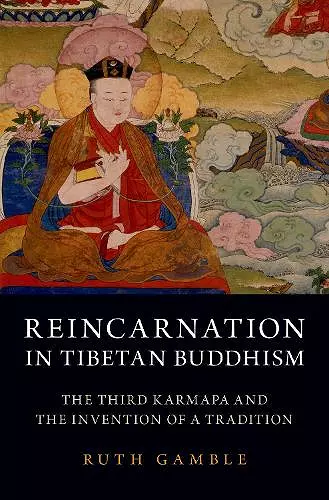Reincarnation in Tibetan Buddhism
The Third Karmapa and the Invention of a Tradition
Format:Hardback
Publisher:Oxford University Press Inc
Published:6th Sep '18
Currently unavailable, and unfortunately no date known when it will be back

Reincarnation in Tibetan Buddhism examines how the third Karmapa hierarch, Rangjung Dorjé (1284-1339) transformed reincarnation from a belief into a lasting Tibetan institution. Born the son of an itinerant, low-caste potter, Rangjung Dorjé went on to become a foundational figure in Tibetan Buddhism and a teacher of the last Mongolian emperor. He became renowned for his contributions to Buddhist philosophy, literature, astrology, medicine, architecture, sacred geography and manuscript production. But, as Ruth Gamble demonstrates, his most important legacy was the transformation of the Karmapa reincarnation lineage to ensure that, after his death, subsequent Karmapas were able to assume power in the religious institutions he had led. The inheritance model of reincarnation instituted by Rangjung Dorjé changed the Tibetan Plateau's power relations, which until that time had been based on family associations, and created a precedent for later reincarnate institutions, including that of the Dalai Lamas. Drawing on Rangjung Dorjé's hitherto un-translated autobiographies and autobiographical songs, this book shows that his reinvention of reincarnation was a self-conscious and multi-faceted project, made possible by Rangjung Dorjé's cultural, social, and political standing and specific historical and geographical circumstances. Exploring this combination of agency and historical coincidence, this is the first full-length study of the development of the reincarnation institution.
This volume is both intricate in detail and thoroughly researched. Those with an interest in Tibetan Buddhism will undoubtedly find this volume invaluable. * Joseph Chadwin, Religious Studies Review *
Reincarnation in Tibetan Buddhism serves as a clear introduction to the history and study of the tulku system by identifying the important cultural factors that informed its inception, and by giving them context in the life story of Rangjung Dorjé. As such, it is recommended for graduate students and scholars of Buddhism, Tibetan culture, and religious history. Kagyupa practitioners who draw their lineage back to Rangjung Dorjé and who follow the current Karmapa(s) will also find this book useful for situating themselves in this tradition and for making sense of how it came to be. Overall, it is a lucid account of the life of the Third Karmapa, a good analysis of the various aspects that informed his life, and a great investigation into the origins of the tulku system in Tibet. * Colin H. Simonds, Canadian Journal of Buddhist Studies *
Ruth Gamble's book is a sensitive and subtle guide to the many facets of Rangjung Dorjé's extraordinary life. She treats Rangjung Dorjé not just as a cultural or sociological cipher, but as a fully-rounded human individual struggling to live a meaningful life in difficult circumstances. Her narrative tells us much that is new and revealing about Tibet and about the shape and meaning of Tibetan spiritual lives. This book is a remarkable achievement which does full justice to its equally remarkable subject. * Geoffrey Samuel, Cardiff University/University of Sydney *
This is a landmark study and a must read for anyone interested in the Tibetan system of reincarnating lamas or Tibetan Buddhism more generally. Gamble skillfully explores the writings of Rangjung Dorjé, the third Karmapa and the person most often credited with initiating the practice of recognizing child successors of deceased masters, and contextualizes this with a broad range of historical sources. This work overturns much of the conventional wisdom in the field and provides a fascinating and eminently readable analysis of a pivotal period in Tibetan history and of one of its most influential figures. * John Powers, Deakin University *
Reincarnation in Tibetan Buddhism marks a refreshingly new approach to unraveling the presuppositions, lingering sentiments and conceptual strategies behind the third Karmapa Rangjung Dorjé's reinvention of the oldest documented lineage in Tibet, drawing here from the incarnate's personal and surprisingly informative writings. A most welcome contribution that covers the transitional process from its incipient beginnings until it turned into a full-fledged tradition. * Per K. Sørensen, University of Leipzig, Numata Visiting Professor, University of California, Berkeley *
ISBN: 9780190690779
Dimensions: 157mm x 239mm x 33mm
Weight: 599g
340 pages